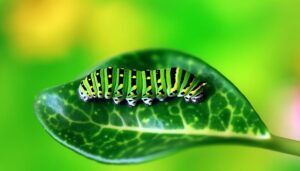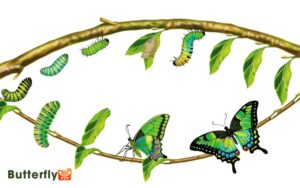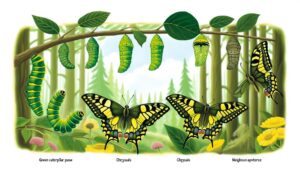How Long Do Tiger Swallowtail Butterflies Live
The lifespan of Tiger Swallowtail butterflies (Papilio glaucus) largely depends on their developmental stages and environmental conditions. The egg stage spans 4 to 10 days, while the larval stage lasts about 3 to 4 weeks.
Pupation takes 10 to 20 days within the chrysalis. Once they reach adulthood, their life expectancy ranges from a few days to several weeks, focusing on reproduction and nectar foraging.
Temperature, humidity, and predation greatly influence these durations. To understand the intricacies of their life cycle and the impact of various ecological factors, one must consider the detailed analysis provided herein.

Key Takeaways
- The adult Tiger Swallowtail butterfly typically lives from a few days to several weeks.
- Environmental factors like temperature and humidity significantly influence the lifespan of Tiger Swallowtail butterflies.
- The entire life cycle, from egg to adult, spans several weeks to months based on environmental conditions.
- Predation and habitat quality also impact the longevity of adult Tiger Swallowtail butterflies.
Life Cycle Overview
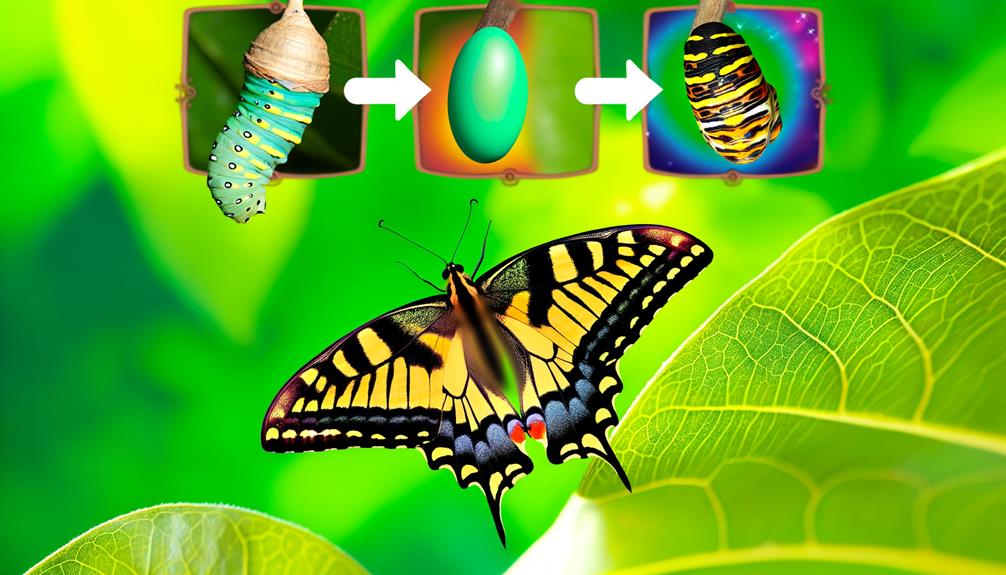
The life cycle of the Tiger Swallowtail butterfly (Papilio glaucus) encompasses four distinct stages: egg, larva (caterpillar), pupa (chrysalis), and adult. Each stage plays a critical role in the development and survival of the species.
Initially, eggs are meticulously laid on host plants, ensuring ideal conditions for the emerging larvae.
During the larval stage, the caterpillar undergoes multiple molts, dramatically increasing in size while consuming vast amounts of plant material.
Following this, the larva transforms into a pupa within a chrysalis, where significant morphological changes occur through metamorphosis.
Egg Stage Duration
Typically, the egg stage of the Tiger Swallowtail butterfly lasts between four to ten days, depending on environmental conditions such as temperature and humidity.
During this period, the eggs, which are approximately 1.2 mm in diameter, undergo rapid embryonic development. Higher temperatures generally accelerate metabolic rates, shortening the duration of the egg stage, while lower temperatures can prolong it.
Humidity also plays a significant role, as excessively dry conditions may desiccate the eggs, whereas ideal humidity levels support proper development.
The eggs are often laid singly on the leaves of host plants, which provide necessary nutrients post-hatching.
Understanding the variables affecting this stage is essential for conservation efforts and for those cultivating butterfly gardens, ensuring favorable conditions for successful hatching.
Larval Stage Length
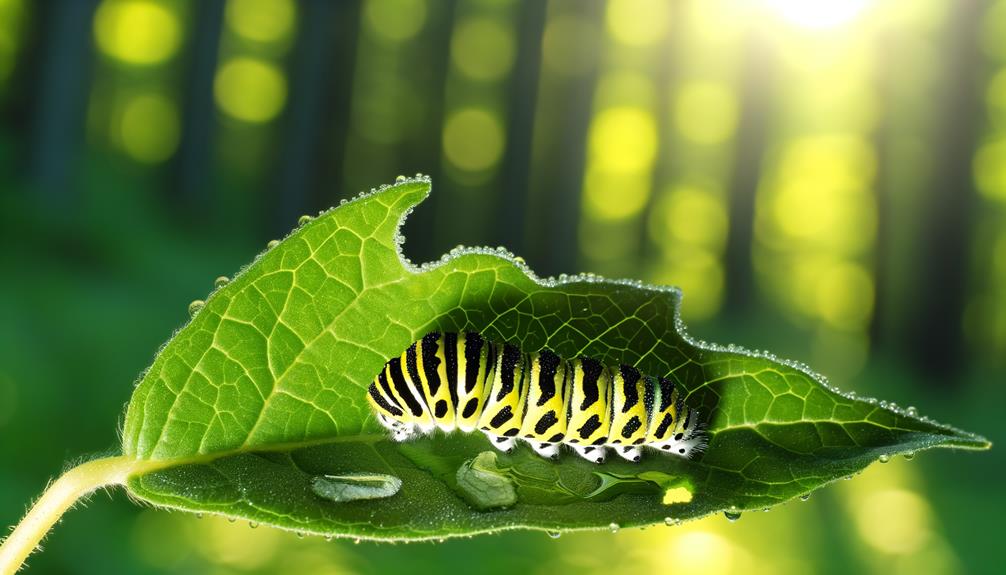
The larval stage of Tiger Swallowtail butterflies, encompassing approximately three to four weeks, is characterized by distinct growth and molting phases.
During this period, larvae undergo multiple instars, shedding their exoskeletons to accommodate rapid growth.
Concurrently, their feeding habits focus primarily on the leaves of host plants, which provide the necessary nutrients for development.
Growth and Molting Phases
During the larval stage, Tiger Swallowtail butterflies undergo multiple instars, each culminating in a molting phase that facilitates further growth.
The larval stage can last from 3 to 5 weeks, depending on environmental conditions such as temperature and food availability. Each instar represents a period of growth between molts, during which the caterpillar sheds its exoskeleton to allow for expansion.
Typically, there are five instars, with the final one preparing the larva for pupation. The molting process is critical for the caterpillar's development, enabling it to increase in size and undergo necessary physiological changes.
This phase embodies the dynamic shift from larva to pupa, marking a pivotal period in the life cycle of the Tiger Swallowtail butterfly.
Feeding Habits Overview
In the larval stage, Tiger Swallowtail butterflies exhibit voracious feeding habits, primarily consuming host plant leaves to accumulate the necessary nutrients for development. This intensive feeding period is vital for the larvae to build sufficient energy reserves, which will support their metamorphosis into adult butterflies. Typically, the larval stage spans approximately 3-4 weeks, during which the caterpillars undergo several instars, or molting phases, to accommodate their rapid growth.
| Larval Stage Length | Key Feeding Habits |
|---|---|
| 1-2 weeks | Initial leaf consumption |
| 2-3 weeks | Increased feeding rate |
| 3-4 weeks | Peak nutrient intake |
These feeding habits are essential for the larvae to achieve the size and strength required for successful pupation, ensuring their progression to the butterfly stage.
Pupal Phase Timeframe
The pupal phase of the Tiger Swallowtail butterfly, during which it resides within the chrysalis, typically lasts between 10 and 20 days.
This duration can be considerably influenced by various environmental factors, including temperature and humidity levels.
Understanding these parameters is essential for accurately predicting the emergence of the adult butterfly.
Duration in Chrysalis
The pupal phase of the Tiger Swallowtail butterfly typically ranges from 10 to 20 days, although environmental conditions can considerably affect this timeframe.
During this critical stage, the caterpillar transforms into a butterfly within the protective casing of the chrysalis. This metamorphosis involves significant physiological changes, including the breakdown and reorganization of tissues.
The duration in chrysalis is influenced by factors such as temperature and humidity, which regulate metabolic rates and developmental speed. While warmer temperatures generally accelerate development, cooler conditions may prolong the pupal period.
This variability guarantees that the emergent butterflies are ideally timed for survival and reproduction. Understanding the precise dynamics of the chrysalis phase is essential for comprehending the life cycle of the Tiger Swallowtail.
Environmental Impact Factors
Environmental factors play a significant role in determining the duration of the Tiger Swallowtail butterfly's pupal phase, with temperature and humidity being primary influencers.
Ideal temperatures ranging from 20°C to 30°C generally expedite metamorphosis, reducing the pupal phase to approximately 10-14 days. Conversely, lower temperatures can prolong this stage to several weeks or even months, as metabolic processes decelerate.
Humidity levels also affect pupal development; optimal relative humidity (60-80%) maintains appropriate moisture levels necessary for physiological transformation. Extreme fluctuations in humidity can lead to desiccation or fungal infections, potentially compromising pupal viability.
Therefore, the intricate interplay between temperature and humidity underscores the critical nature of environmental conditions in the successful emergence of the Tiger Swallowtail butterfly.
Adult Lifespan
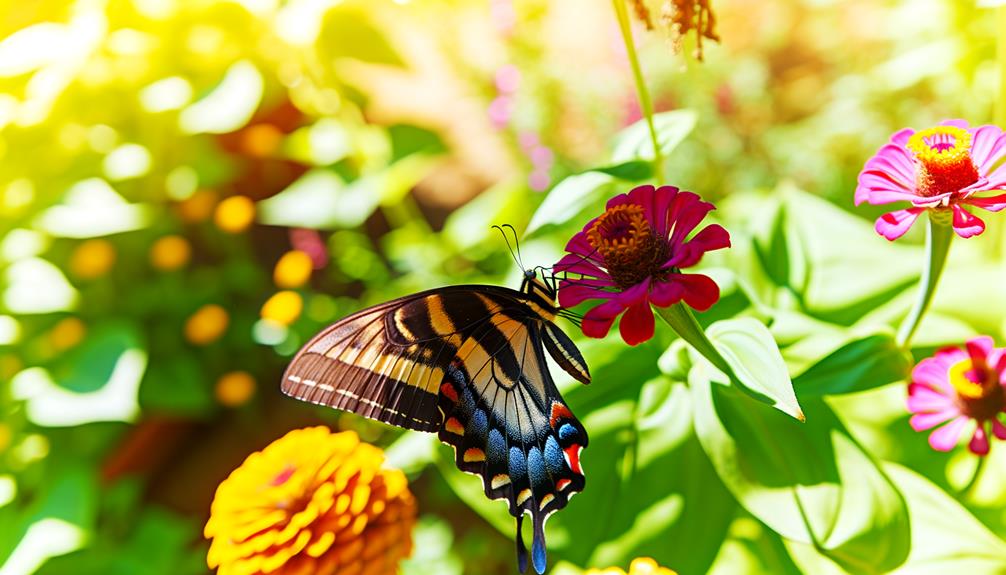
Adult Tiger Swallowtail butterflies exhibit a variable lifespan, typically ranging from a few days to several weeks, influenced by environmental factors and predation pressures. Their longevity depends on factors such as temperature, availability of food sources, and threats from predators. Similar to Tiger Swallowtails, how long Palamedes Swallowtails live also varies based on these environmental conditions. In favorable circumstances, both species can maximize their lifespan, allowing them more opportunities to reproduce and contribute to their populations.
The adult stage is primarily dedicated to reproduction, during which time males actively seek out females for mating. After successful copulation, females lay eggs on host plants, initiating the next generation.
The brief adult phase is characterized by foraging for nectar, which provides the necessary energy for flight and reproduction. Predators such as birds and spiders, coupled with adverse weather conditions, can notably reduce their lifespan.
Nonetheless, this period is essential for genetic dissemination and species perpetuation, highlighting the delicate balance between ecological constraints and biological imperatives in the life cycle of Tiger Swallowtails.
Environmental Influences
Environmental factors play an essential role in determining the lifespan of Tiger Swallowtail butterflies, with climate and habitat being particularly significant.
Variations in temperature and humidity can directly impact their metabolic rates and developmental stages, while habitat quality influences their access to essential resources such as food and shelter.
Analyzing these environmental influences provides insight into the survival strategies and longevity of these butterflies.
Climate and Life Span
Variations in climate significantly impact the life span of Tiger Swallowtail butterflies by altering their developmental rates and survival probabilities.
Warmer temperatures generally accelerate metabolic processes, leading to quicker maturation cycles but potentially shorter life spans due to increased physiological stress. Conversely, cooler climates may prolong developmental stages, allowing for extended longevity but also heightening vulnerability to predation and disease.
Precipitation levels further influence habitat quality, affecting larval food availability and adult nectar sources. Additionally, extreme weather events such as droughts or heavy rains can directly reduce population numbers by destroying habitats and food resources.
Habitat and Survival
In addition to climatic factors, the specific habitats in which Tiger Swallowtail butterflies reside play a pivotal role in determining their survival and life span.
These butterflies typically inhabit deciduous forests, river valleys, and suburban gardens, where host plants like wild cherry and tulip trees are abundant.
The availability of nectar sources, such as milkweed and thistle, directly influences their energy intake and reproductive success.
Predation pressure from birds, insects, and small mammals also greatly affects their longevity.
Moreover, habitat fragmentation and pesticide exposure can lead to increased mortality.
Consequently, the interplay between habitat quality and environmental stressors is critical, underscoring the need to preserve natural ecosystems to guarantee the continued survival of the Tiger Swallowtail butterfly.
Predators and Threats
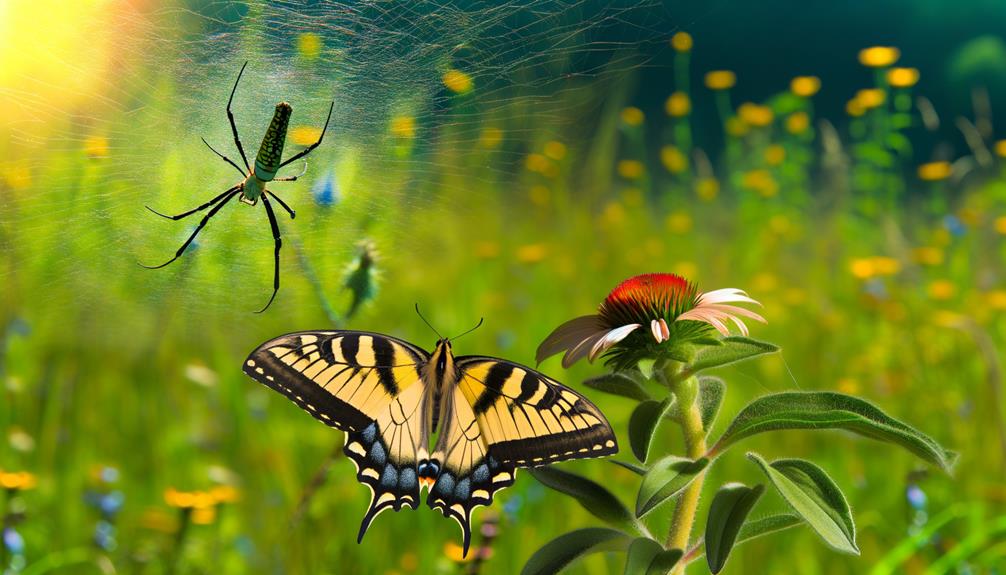
Predation and habitat loss constitute significant threats to the lifespan of Tiger Swallowtail Butterflies.
Avian predators, such as birds, and arthropods, including spiders and wasps, frequently prey on both larvae and adult butterflies. Additionally, parasitism by tachinid flies and braconid wasps can drastically reduce survivorship.
Habitat degradation, primarily due to urbanization and deforestation, further exacerbates these threats by diminishing food sources and breeding grounds. Pesticide application in agricultural areas also poses a significant risk, leading to both direct toxicity and the depletion of essential nectar plants.
Conservation efforts focusing on habitat preservation and the reduction of chemical pollutants are imperative to mitigate these threats and guarantee the continued viability of Tiger Swallowtail populations.
Seasonal Variations
The lifecycle and behavior of Tiger Swallowtail Butterflies exhibit significant alterations in response to seasonal changes, particularly influenced by temperature and photoperiod. These factors dictate the developmental stages and activity periods of the butterflies. During warmer months, the butterflies experience accelerated growth and increased reproductive activity. Conversely, cooler temperatures and shorter days prompt diapause, a state of suspended development, ensuring survival through adverse conditions.
| Season | Butterfly Behavior |
|---|---|
| Spring | Emergence from diapause, mating |
| Summer | Active feeding, rapid development |
| Autumn | Preparation for diapause |
Understanding these patterns provides insights into their adaptive mechanisms, essential for conservation efforts. The temporal shifts in their lifecycle underscore the intricate balance they maintain with their environment.
Habitat Impact

Recognizing the seasonal variations in Tiger Swallowtail Butterflies' lifecycle, it is essential to examine how habitat conditions influence their distribution, behavior, and survival.
Ideal habitats, characterized by abundant host plants such as wild cherry and tulip trees, greatly enhance larval development and adult health. Conversely, habitat fragmentation and loss due to urbanization disrupt these important resources, leading to diminished populations.
Microclimatic conditions within habitats, including temperature and humidity, further affect metabolic rates and oviposition success. Additionally, the availability of nectar sources plays a fundamental role in sustaining adult butterflies, particularly during mating and migration.
Therefore, habitat quality and integrity are paramount to the longevity and ecological success of Tiger Swallowtail Butterflies.
Conservation Efforts
Effective conservation efforts are essential for mitigating the adverse impacts of habitat loss and climate change on Tiger Swallowtail Butterflies. These initiatives guarantee the longevity and ecological balance of this species.
Key strategies include:
- Habitat Restoration: Rehabilitating natural environments to support butterfly populations.
- Climate Adaptation: Implementing measures to mitigate the effects of climate variability.
- Pollinator Programs: Promoting the cultivation of nectar-rich plants to aid in feeding.
- Public Awareness: Educating communities about the importance of butterfly conservation.
These targeted efforts not only enhance the lifespan of Tiger Swallowtail Butterflies but also contribute to broader biodiversity conservation, offering a pathway to environmental resilience and freedom of natural ecosystems.
Conclusion
The tiger swallowtail butterfly, with its ephemeral yet intricate life cycle, navigates a gauntlet of developmental stages, natural predators, and environmental challenges, culminating in an adult lifespan that often barely surpasses a fleeting few weeks.
The larval and pupal stages are marked by meticulous biological transformations, while conservation efforts endeavor to mitigate habitat destruction and climatic variances that threaten their existence.
This species' lifecycle, albeit brief, epitomizes the delicate balance within ecosystems and underscores the urgency of biodiversity preservation.

